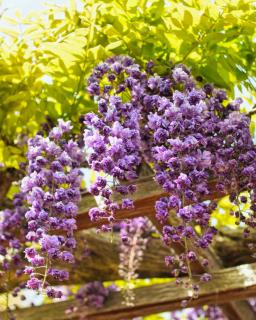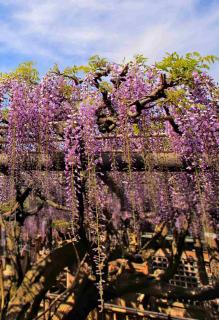

Wisteria is a fabulous climbing vine with abundant and deliciously fragrant blooms.
Wisteria key facts
Name – Wisteria
Family – Fabaceae
Type – climbing vine
Height – 16 to 50 feet (5 to 15 meters)
Exposure – Full sun
Soil – ordinary
Foliage – deciduous – Flowering – spring
Care, pruning and watering help enhance blooming. Try this plant and you will never regret it…
It is recommended to plant them in spring or in fall in a mix of garden soil and soil mix together with soil conditioner such as manure and seaweed.
You may also plant in summer if you’re able to water regularly and avoid heat waves.
Sowing Wisteria seeds collected from pods may produce seedlings, but you must know that this technique results in a long waiting period before the first flowers appear: it can take 10 to 15 years…
 Pruning Wisteria is very easy, and must be done every year if you don’t want your Wisteria to invade more than its allotted territory.
Pruning Wisteria is very easy, and must be done every year if you don’t want your Wisteria to invade more than its allotted territory.
This can take place anytime during the plant’s dormant state, when leaves have fallen off until the end of winter.
Do not prune during frost spells.
When purchased, Wisteria usually has a single long stem, that branches out several times.
To train Wisteria into a tree-shape, you must stake this long stem with a sturdy stake. If you wish your Wisteria to be 5 feet (1.5 meters) tall, choose a 5 feet (1.5 meters) tall stake, but don’t make it any taller than 6 to 8 feet (2 to 2.5 m).
 Attach the main stem to this stake, as close as possible with “figure eight” ties sold in horticulture stores. Avoid strings and wires that would dig into the trunk.
Attach the main stem to this stake, as close as possible with “figure eight” ties sold in horticulture stores. Avoid strings and wires that would dig into the trunk.Although Wisteria are rarely subject to diseases, leaves frequently turn yellow.
If this happens in fall, don’t worry, it is normal because Wisteria lose their leaves in winter.
But if leaves turn yellow or lose their color in summer, the soil is probably responsible and leads to chlorosis.
Wisteria produce very beautiful flowers in violet blue bunches 12 to 16 inches (30 to 40 cm) long.
Perfect climbing vine for pergolas and gazebos, you’ll be amazed at their abundant bloom and the cool air under their shade during the hot summer heat…
Don’t amend and fertilize the soil too much, since this could stimulate leaf growth instead of flowers on Wisteria.
Observant gardeners also share that you should not go against the direction of growth that your Wisteria have chosen, unless you train them with wires for instance.
Read also on the topic of climbing plants: